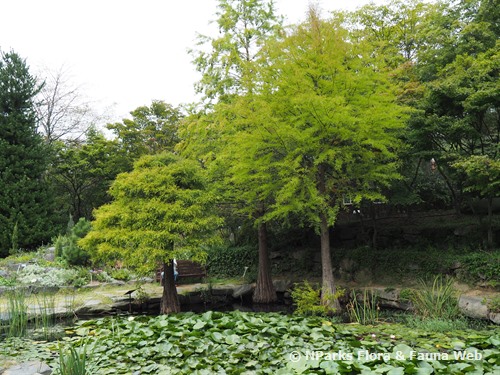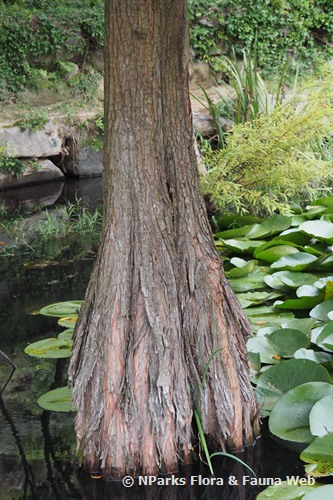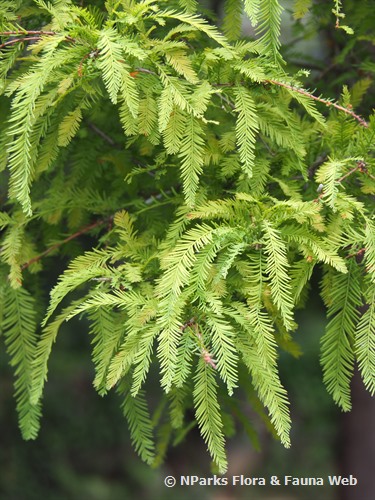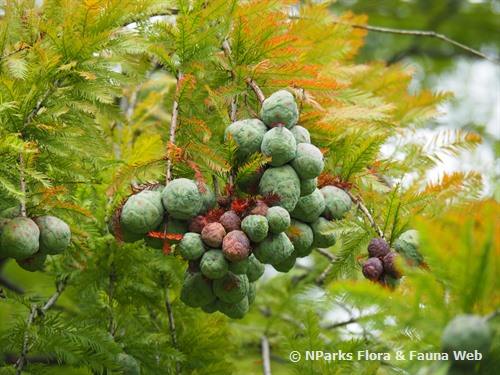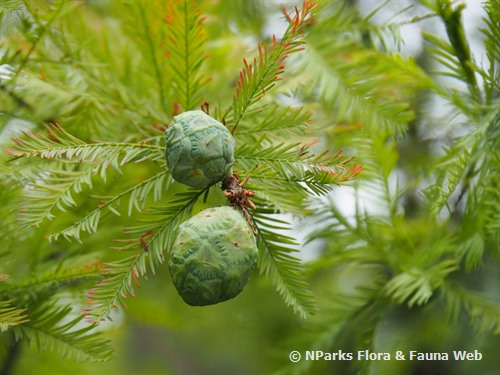
Back
Taxodium distichum (L.) Rich.
| Family Name: | Taxodiaceae |
| Common Name: | Swamp Cypress, Bald Cypress, Gulf Cypress, Marsh Cypress, Pond Cypress |
Name
Classifications and Characteristics
| Plant Division | Angiosperms (Flowering Seed Plants) (Dicotyledon) |
|---|---|
| Plant Growth Form | Tree (Big (>30m), Medium (16m-30m)), Aquatic (Emergent Aquatic) |
| Lifespan (in Singapore) | Perennial |
| Mode of Nutrition | Autotrophic |
| Maximum Height | 25 m to 40 m |
| Tree or Palm – Trunk Diameter | 2 m to 4 m |
Biogeography
| Native Distribution | Eastern & Central USA |
|---|---|
| Native Habitat | Terrestrial (Riverine) |
| Preferred Climate Zone | Temperate |
Description and Ethnobotany
| Growth Form | Medium to large coniferous tree, reaching up to 40m height in its natural range. Crown relatively pyramidal when young, becoming more spreading with age. |
|---|---|
| Trunk | Base distinctively flared when plant grows in standing water. Bark greyish to reddish-brown, peeling in long stringy strips. |
| Foliage | Linear and needle-like, arranged in 2 ranks on opposite sides of branchlets, which unlike those of most other cypresses, are deciduous and turn rusty-red, before being shed in winter in its natural range -- thus giving rise to its common name Bald Cypress. |
| Others - Plant Morphology | Roots: Submerged roots produce woody cone-shaped projections ("cypress knees") that rise above the water surface. "Cypress knees" thought to function as anchors in unstable soils, or as a means of respiration under challenging conditions of long-period submergence in low-oxygen waters.Cones: Species is monoecious, with scale-covered male and female cones (or strobili) found on the same tree. Seed (female) cones globular, pollinated in winter and ripen from green to greyish-brown in 12 months, before disintegrating to release 5-10mm long triangular seeds -- the largest within the Cupressaceae family. Seeds dispersed onto drier ground by receding floodwaters, as well as by cone-eating squirrels. Cone production not observed under local conditions. |
| Habitat | Occurs in permanently-flooded swamps, alluvial wetlands, flood plains, lake edges and river banks, often forming pure colonies. |
| Cultivation | Healthy specimens can live up to 500 years or more. Young trees exhibit rapid growth that slows down down with age. Adapted to permanantly-flooded sites, but performs well and reportedly grows more quickly in normal soils, and are relatively drought-tolerant when established -- although in nature, seedlings tend to be out-competed first by other vegetation that occur naturally at drier sites. Prefers acidic soils, and exhibits leaf-yellowing when planted in alkaline or neutral pH sites. Requires continental climates with long hot summers for good growth and viable seed production. Tolerant of coppicing, and can sprout back from trunks exploded by lightning strikes, when most other types of trees would probably perish. Propagate by cuttings, or seeds which germinate quickly in wet soils but drown if submerged underwater. |
| Etymology | Genus epithet 'Taxodium' means resembling the Taxus (Yew) genus. Species epithet 'distichum' means '2-ranked', alluding to the foliar-needle arrangement. |
| Ethnobotanical Uses | Food (Herb or Spice) Others: Timber: Timber is scentless, as well as very water and rot-resistant, hence often called "wood eternal". Wood used to construct bridges, docks, boats and buildings. Highly-valued mineralized prehistoric wood mined from swamps and used for wood carvings. Bark used for cordage. Medicinal: Cone resin used as analgesic for wounds. Culture: Officially designated the state tree of Louisiana in 1963. Often regarded as the living emblem of the southern US swamps. |
Landscaping Features
| Desirable Plant Features | Ornamental Foliage |
|---|---|
| Landscape Uses | Riverine |
| Thematic Landscaping | Water Garden, Bioswales / Sunken Garden, Naturalistic Garden |
| Plant & Rootzone Preference or Tolerance Remarks | Grows well too in normal dry soils, although tends to be out-competed by tree species naturally distributed at such sites. Established trees are drought-tolerant. |
Plant Care and Propagation
| Light Preference | Full Sun |
|---|---|
| Water Preference | Moderate Water, Lots of Water |
| Plant Growth Rate | Moderate |
| Rootzone Tolerance | Waterlogged Soils (Drains Site), Drought Tolerant, Fertile Loamy Soils, Well-Drained Soils, Acidic (low pH) Soils |
| Maintenance Requirements | Moderate |
| Potential Problems | Does not tolerate alkaline or neutral pH soils, which will cause leaf chlorosis. |
| Propagation Method | Seed, Stem Cutting |
Foliar
| Mature Foliage Colour(s) | Green |
|---|---|
| Leaf Area Index (LAI) for Green Plot Ratio | 2.5 (Tree - Open Canopy) |
Non - Foliar and Storage
| Trunk Type (Non Palm) | Woody |
|---|---|
| Mature Bark Texture | Peeling / Flaking / Papery |
| Stem Type & Modification | Woody |
| Root Type | Underground (Tap Root, Fibrous Root), Aboveground (Buttress Root, Pneumatophore / Pencil Root) |
Floral (Angiosperm)
| Flower & Plant Sexuality | Unisexual Flowers , Monoecious |
Fruit, Seed and Spore
| Mature Fruit Colour(s) | Brown, Silver / Grey |
|---|
Image Repository
Others
| Master ID | 1883 |
|---|---|
| Species ID | 3176 |
| Flora Disclaimer | The information in this website has been compiled from reliable sources, such as reference works on medicinal plants. It is not a substitute for medical advice or treatment and NParks does not purport to provide any medical advice. Readers should always consult his/her physician before using or consuming a plant for medicinal purposes. |

